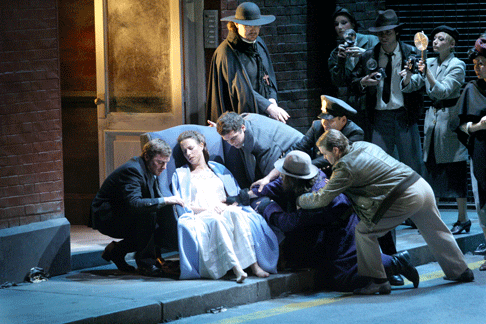In his prize winning account of music in the twentieth century *The Rest is Noise* New Yorker magazine critic Alex Ross accords Menotti two mentions — 1) a composer invited into Jacqueline Kennedy’s newly art responsive White House, and 2) an openly gay composer. There is no reference to Menotti’s art perhaps because musically it was a dead end street, and because Menotti’s melodrama, like the broad, latter day melodramma of Italian *verismo* had soon morphed first into cinematic realism and then disappeared into populist television.
Ironically Menotti did leave a significant artistic legacy. He founded the Festivals of Two Worlds first in Spoleto (1958) and then in Charlotte (1977), stalwart bastions of everything that is progressive in opera and music — a contradiction left unaddressed by Alex Ross.
*The Saint of Bleecker Street* premiered in 1953, rife with the baggage of the post WWII era. This was when operatic art was expected to abandon its high perches and descend onto Main Street and long runs in Broadway theaters. *The Saint of Bleecker Street* endured 72 performances. Its has had sporadic revivals in the U.S., notably a 1978 televised version from New York City Opera with Catherine Malfitano (once a Marseilles *Butterfly*) and a 2007 revival at Central City Opera directed by Mme. Malfitano.
Immigrant life in New York, the quintessential melting pot of the early and mid-century America, is the background for Menotti’s tale of alienation, a subject deeply explored in the ’50’s by artists like Edward Hopper and George Tooker. In fact Tooker’s iconic painting of alienation *The Subway* (1950) was the basis of the design of the original Broadway production. But Menotti complicated his take on the alienation of Italian immigrants by slathering on a lurid, melodramatic overlay of questionable religious fervor.
If nothing more Menotti’s Broadway success spawned a true masterpiece, Leonard Bernstein’s *West Side Story* that had its premiere in 1956, just three years later. It is a work so similar in subject that its provenance from Menotti’s little opera is blatantly obvious. But where Bernstein incorporated and expanded the musical discoveries of the twentieth century in his score Menotti kept his tonalities banale and his structures derivative of traditional sources.
The Marseilles *Saint of Bleecker Street* production was in the hands of British director Stephen Metcalf and British designer Jamie Vartan (neither boast American credits) who placed all the action in a courtyard between two nineteenth century oddly un-New York tenement facades. This confined space supported the scene changes uncomfortably, cramping Menotti’s facile music into a dramatic focus it could not support. Missing was the punctuation of Broadway’s quick-change theatricality, changes that in fact Menotti cleverly incorporated into his descriptive music — *‡ la* Puccini.

The Broadway style thrives on razzle-dazzle, and *messieurs* Menotti and Metcalf obliged with a couple of good, lively scenes — the murder of Assunta and the assumption of the Bleecker Street saint Annina — but the overall scenic rhythm was in fits and starts that missed a Broadway crescendo.
Somehow the underlying theme of incest was always gnawing, perhaps this was subtle direction by Mr. Metcalf or more likely it is latent Menotti, an active participant in the sexually giddy circles of New York’s artistic *crËme de la crËme* of that era. This thread carried a potential wallop that never materialized, impossible obviously for Main Street art of the 1950’s but not for the jaded sensibilities of this new century — a missed opportunity for a new production of this potentially shabby little shocker.

There was not an American in the cast, unusual for almost any opera production in the south of France these days. Though she gave a fine, detailed performance French soprano Karen Vourc’h did not capture a saintly rapture, or the crazed rapture of a consenting sexual victim. She was a too plain, too real Annina. Hungarian tenor Attila B. Kiss used a Broadway style voice to expound the trails of the lover Michele when a more beautiful voice could have added dimension to this role. His too careful enunciation of the American underscored the homelessness of this Marseilles production.
Armenian mezzo soprano Juliette Galstian was a good Assunta, capturing a convincing, grandly temperamental jealousy as Michele’s jilted girl friend. But her character was betrayed by the too stylish lines of her costume, in fact the period *haute couture* look of all womens’ costumes in this production was more important than the character they clothed (a typical complaint to the hereabouts ubiquitous costume design of Katia Duflot).

Russian bass Dmitry Ulyanov was a fish-out-of-water as the priest Don Marco, simply to young and too green to inhabit the soutane of the spiritual and temporal shepherd of Menotti’s needy Italian immigrants. The myriad of supporting roles were however well cast and uniformly effective.
British conductor Jonathan Webb played the Menotti score for all it was worth. The Friday (02/19/10) evening audience indicated by its warm but limited enthusiasm that it had not been duped into believing it had had a significant opera experience.
Michael Milenski
image=http://www.operatoday.com/Bleeker_01.gif
image_description=Photo by Christian Dresse courtesy of OpÈra de Marseille
product=yes
product_title=Gian Carlo Menotti: The Saint of Bleecker Street
product_by=Annina: Karen Vourc’h; Assunta: Juliette Galstian; Carmela: Pascale Beaudin; Maria Corona: Sandrine Eyglier; Desideria: Giuseppina Piunti; Michele: Attila B Kiss; Don Marco: Dmitry Ulyanov; Salvatore: Marc Scoffoni. Orchestra and Chorus of the OpÈra de Marseille. Conductor: Jonathan Webb. Stage Director: Stephen Medcalf. Set Design: Jamie Vartan. Costumes: Katia Du?ot. Lighting Design: Simon Corder.
product_id=Photos by Christian Dresse courtesy of OpÈra de Marseille